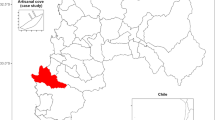Abstract
This paper develops two types of simple models on the dynamic interaction between the stock of fish and the effort expended by fishers: continuous-time/discrete-time models in which a landings tax is incorporated as a control variable available to the management authority. The continuous-time model can describe several ideal options of the optimal tax program; however, unfortunately, it is incapable of choosing the best option. Hence, using the alternative tractable discrete-time model and a computational method, the remaining task of determining a unique optimal tax program is accomplished. The fishery thus managed exhibits a regulated open access.
Similar content being viewed by others
References
Anderson LG (1994) Highgrading in ITQ fisheries. Mar Resour Econ 9(3):209–226
Arnason R (1994) On catch discarding in fisheries. Mar Resour Econ 9(3):189–208
Boyce JR (1992) Individual transferable quotas and production externalities in fishery. Nat Resour Model 6(4):385–408
Boyce JR (1995) Optimal capital accumulation in a fishery: a nonlinear irreversible investment model. J Environ Econ Manage 28(3):324–339
Burt OR, Cummings RG (1970) Production and investment in natural resource industries. Am Econ Rev 60:576–590
Clark CW (1976) Mathematical Bioeconomics: the optimal management of renewable resources. John Willy & Sons, New York, 386 pp
Clark CW, Clarke FK, Munro GB (1979) The optimal exploitation of renewable resource stocks: problems of irreversible investment. Econometrica 47(1):25–47
Conrad JM (1992) A bioeconomic model of the pacific whiting. Bull Math Biol 54(2/3):219–239
Conrad JM (1995) Bioeconomic models of the fishery. In: Bromley DW (ed) The handbook of environmental economics. Blackwell, Cambridge, pp 405–432
Conrad JM (1999) Resource economics. Cambridge University Press, Cambridge, 213 pp
Copes P (1986) A critical review of the individual quota as a device in fisheries management. Land Econ 62(3):278–291
Gordon HS (1954) The economic theory of a common property resource: the fishery. J Polit Econ 62:124–142
Grafton RQ (1996) Individual transferable quotas: theory and practice. Rev Fish Biol Fish 6:5–20
May RM (1975) Biological populations obeying difference equations: stable points, stable cycles and chaos. J Theo Biol 51:511–524
McKelvey R (1985) Decentralized regulation of a common property renewable resource industry with irreversible investment. J Environ Econ Manage 12(4):287–307
Ruddle K (1989) Solving the common-property dilemma: village fisheries rights in Japanese coastal waters. In: Berkes F (ed) Common property resources. Belhaven Press, London, pp 168–184
Scott AD (1955) The fishery: the objective of sole ownership. J Polit Econ 63:116–124
Smith VL (1968) Economics of production from natural resources. Am Econ Rev 58:409–431
Smith VL (1969) On models of commercial fishing. J Polit Econ 77:181–198
Author information
Authors and Affiliations
Corresponding author
Rights and permissions
About this article
Cite this article
Marutani, T. On open access and optimal landings tax. Rev Fish Biol Fisheries 16, 115–124 (2006). https://doi.org/10.1007/s11160-006-9007-9
Received:
Accepted:
Published:
Issue Date:
DOI: https://doi.org/10.1007/s11160-006-9007-9




